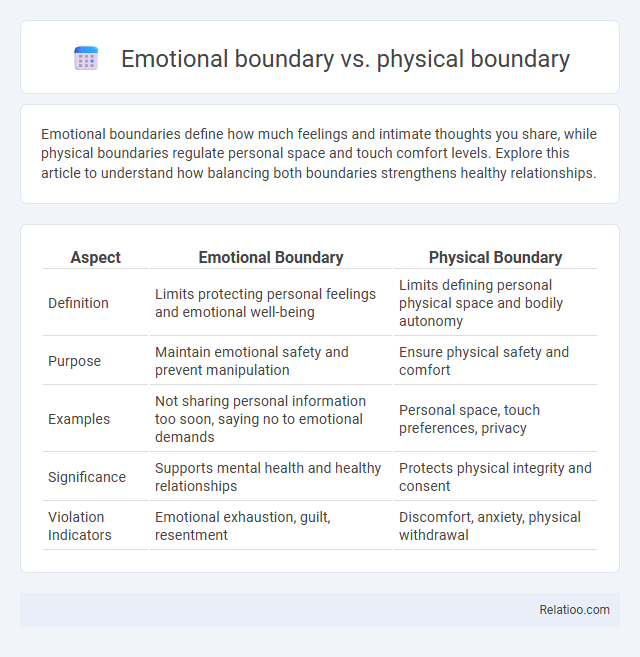Emotional boundaries define how much feelings and intimate thoughts you share, while physical boundaries regulate personal space and touch comfort levels. Explore this article to understand how balancing both boundaries strengthens healthy relationships.
Table of Comparison
| Aspect | Emotional Boundary | Physical Boundary |
|---|---|---|
| Definition | Limits protecting personal feelings and emotional well-being | Limits defining personal physical space and bodily autonomy |
| Purpose | Maintain emotional safety and prevent manipulation | Ensure physical safety and comfort |
| Examples | Not sharing personal information too soon, saying no to emotional demands | Personal space, touch preferences, privacy |
| Significance | Supports mental health and healthy relationships | Protects physical integrity and consent |
| Violation Indicators | Emotional exhaustion, guilt, resentment | Discomfort, anxiety, physical withdrawal |
Understanding Emotional Boundaries
Emotional boundaries define the limits of one's emotional responsibility and help distinguish personal feelings from others', preventing emotional exhaustion and codependency. Physical boundaries involve personal space and bodily autonomy, ensuring comfort and safety in physical interactions. Understanding emotional boundaries is crucial for healthy relationships, as it allows individuals to protect their emotional wellbeing while fostering empathy and respect.
Defining Physical Boundaries
Physical boundaries refer to the personal space and bodily limits that protect your physical well-being and sense of safety, such as preferences for touch and proximity. Emotional boundaries involve managing your feelings and emotional energy by distinguishing your emotions from others' and deciding how much emotional sharing feels comfortable. Clear understanding and respect for physical boundaries help maintain healthy relationships by preventing discomfort and promoting mutual respect.
Key Differences Between Emotional and Physical Boundaries
Emotional boundaries define how individuals manage their feelings and disclose personal information, while physical boundaries pertain to personal space and bodily autonomy. Emotional boundaries involve setting limits on emotional involvement and protecting one's mental well-being, whereas physical boundaries center on comfort with touch and physical proximity. Key differences lie in their focus: emotional boundaries regulate internal feelings and interactions, while physical boundaries address external, tangible contact and spatial limits.
Importance of Setting Healthy Boundaries
Setting healthy boundaries is crucial for maintaining emotional well-being, as emotional boundaries protect personal feelings and prevent emotional exhaustion, while physical boundaries safeguard personal space and physical safety. Clear differentiation between emotional and physical boundaries enhances relationship quality, reduces stress, and strengthens self-respect. Prioritizing these boundaries empowers individuals to communicate needs effectively and fosters mutual trust in interpersonal interactions.
Signs of Weak Emotional Boundaries
Weak emotional boundaries can manifest as difficulty saying no, constantly seeking approval, or feeling responsible for others' emotions, leading to emotional exhaustion. Unlike physical boundaries that protect your personal space and physical well-being, emotional boundaries safeguard your feelings and mental health from being overwhelmed by others. Recognizing these signs helps you maintain healthy emotional limits, ensuring your relationships remain balanced and respectful.
Signs of Weak Physical Boundaries
Weak physical boundaries often manifest as discomfort with personal space violations, difficulty saying no to unwanted touch, or a tendency to allow others to dictate physical closeness without consent. Your physical boundaries are vital for ensuring personal safety and comfort, and when these are compromised, it can lead to feelings of vulnerability or resentment. Recognizing signs such as frequent physical discomfort, and inconsistent personal space preferences can help you reinforce and maintain healthy physical limits.
How to Establish Emotional Boundaries
Establishing emotional boundaries involves recognizing and communicating your feelings and limits clearly to protect your mental well-being without compromising relationships. Unlike physical boundaries that regulate personal space and physical touch, emotional boundaries require self-awareness and assertiveness to prevent emotional manipulation or burnout. Techniques such as setting expectations, practicing saying no, and seeking support from trusted individuals enhance emotional resilience and maintain healthy connections.
Steps to Create Physical Boundaries
Establishing physical boundaries involves clearly defining personal space and setting limits on physical touch to protect your well-being and comfort. Practical steps include communicating your needs assertively, using non-verbal cues like maintaining distance, and respecting others' physical boundaries to foster mutual understanding. Consistent enforcement of these boundaries helps prevent discomfort and promotes healthy interactions in both personal and professional settings.
Impact of Boundaries on Relationships
Emotional boundaries protect individual feelings and foster trust by defining personal space in communication, while physical boundaries regulate personal space to ensure comfort and safety between people. Clear emotional boundaries prevent codependency and promote healthy emotional expression, whereas well-respected physical boundaries reduce conflicts and protect against discomfort or violations. Together, these boundaries maintain mutual respect, enhance intimacy, and build stronger, balanced relationships by ensuring each person's needs are acknowledged and respected.
Maintaining Boundaries for Emotional Well-being
Maintaining emotional boundaries involves recognizing and respecting your feelings without allowing others to manipulate or intrude, which preserves your mental health and self-esteem. Physical boundaries safeguard your personal space and bodily integrity, essential for feeling safe and respected in relationships. Clearly defined emotional and physical boundaries help you manage stress and foster balanced connections, promoting overall emotional well-being.

Infographic: Emotional boundary vs Physical boundary
 relatioo.com
relatioo.com